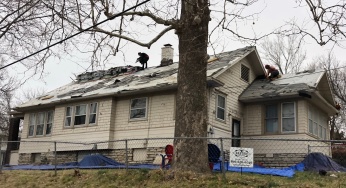Understanding Hail Damage and Tips to Protect Your Roof
Hailstorms can be quite a spectacle, but did you know they can also wreak havoc on your roof? Discover what kind of hail harms your roof, how much damage each roof type can endure, and what you can do to protect your residential and commercial roofing from this force of nature.


Hail Size and Its Potential for Damage
Hail is measured in diameter, much like a ball or an apple. The size can range from tiny pea-sized stones to spheres as large as a softball. It’s worth noting, though, that hail doesn’t have to be enormous to wreak havoc on your roof. Damage can start with hailstones as small as an inch in diameter.
Roofing Materials and Hail Damage
The type of roofing material used on your roof can significantly influence its susceptibility to hail damage.
-
Asphalt Shingles. Asphalt shingles are common and come in various grades. They can be susceptible to hail damage, especially in severe storms with large hailstones. Hail can cause bruises, cracks, and granule loss on asphalt shingles.
-
Wood Shingles/Shakes. Wood shingles or shakes are more prone to hail damage compared to other materials. They can crack, split, or get punctured by hailstones, leading to a need for replacement.
-
Metal Roofing. Metal roofing is relatively durable against hail. While minor dents may occur in severe storms, most metal roofs can resist significant damage from smaller to medium-sized hailstones.
-
Tile Roofing. Concrete or clay tiles are quite resilient to hail impact, particularly larger-sized tiles. They can generally withstand hailstorms well, but checking for any visible damage is essential.
-
Slate Roofing. Slate roofs are highly durable and can withstand hail impacts effectively. However, large hailstones may occasionally cause some chipping or cracking.
Protect Your Roof from Hail Damage
While it’s challenging to completely protect your roof from hail damage, there are some measures you can take to minimize the impact and increase its resistance:
-
Choose impact-resistant materials. Opt for materials designed to withstand hail impacts, such as metal roofing, impact-resistant shingles, or synthetic roofing materials.
-
Maintain your roof. Invest in regular roof inspections and maintenance to identify and address any pre-existing issues that could make it more susceptible to hail damage. Check out “roofers near me reviews” to help you find reliable professionals for routine check-ups.
-
Use hail-resistant roof underlayment. When re-roofing or installing a new roof, consider using hail-resistant underlayment to provide added protection.
Expert Help for Roof Hail Damage
When hail damage occurs, it’s critical to turn to residential and commercial roofing contractors like Easton Roofing for assistance. We can properly assess the damage, provide a suitable repair solution, and help prevent further deterioration. Don’t hesitate to call us at (913) 257-5426, or fill out our online form to get started.
Recent Posts
What You Need to Know About Flat Roof Rot
Flat roofs on commercial and residential buildings face unique challenges. One of the most serious issues…
Shingle Blow-Off: Should You Repair or Replace Your Roof?
Shingle blow-off is a common issue faced by homeowners, especially after harsh weather conditions like…
What Causes Discoloration in Asphalt Shingles?
When homeowners notice discoloration in their asphalt shingle roofs, it can be both an aesthetic…
Roof Replacement in Spring: What to Expect
Spring is a popular time for homeowners in Kansas City, MO to undertake roof replacement…
5 Great Benefits You Can Expect From Asphalt Shingles
When considering roofing materials for your home in Kansas City, MO, asphalt shingles stand out…
Most Common Culprits Behind Gutter Clogs
Gutters play an essential role in the protection and maintenance of your home by effectively…










